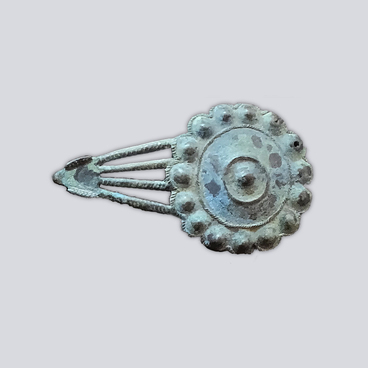The ancient Koban Culture was discovered in 1850s - 1860s. The name comes from the settlement of Uallag-Koban where archeologists came across first findings belonging to that culture.
Vase (the Koban Culture)
Creation period
11th - 8th centuries B.C.
Dimensions
37x35 cm
Technique
Forging, riveting
Exhibition
0
Open in app#1
Vase (the Koban Culture)
#7
#8
The Koban Culture originated in late Bronze Age, flourished in early Stone Age and decayed in the second half of the 1st millennium B.C. For a long time, scientists were split over more exact dating of the culture, but nowadays the most popular is a version by Yevgeniy Krupnov, who, having analyzed all the available data, dated the Koban Culture to 12th - 4th centuries B.C.
#9
Koban tribes were direct descendants from late paleolithic inhabitants of the Caucasus. They lived in mountain gorges and valleys on both sides of the Greater Caucasus mountain range. They established their settlements predominantly near rivers or on flat elevations and hills. The Koban tribes built mudbrick houses, sometimes on cobblestone foundation, less often they built wholly stone houses. The houses traditionally were placed in groups of several rows with walls to each other or around an open space. In large settlements, houses formed entire blocks while streets were paved with rock.
#10
The Koban tribes led sedentary life. They tended sheep in the mountains and kept pigs, poultry and cattle in their yards. They grew wheat, barley, rye and millet.
An important role in Koban settlements was played by special household outbuildings: blacksmith shops, foundries and potteries. They were often located in the outskirts of living quarters, closer to water.
#4
Various Koban bronze items have survived to this day: tool, weapons, elements of horse harness, ornaments, sacral items. Most of them are ornamented with geometric patterns and images of animals.
#11
According to scientist Ruslan Dzattiaty,
‘Items made by Koban craftsmen are characterized by careful manufacture, exclusively high quality of processing and, no doubt, have artistic accomplishments’.
#12
Bronze was also used by Koban craftsmen to make various vessels. The exhibited Vase was found by archeologists in the Kuibyshev Water Reservoir bank erosion near the village of Atabayevo, Laishevsky District of the Tatar Autonomous Soviet Socialist Republic. That finding became a proof of the fact that population of the Middle Volga often traded with Koban Culture craftsmen.
#6
The Vase is made of bronze plates. The bottom has not survived; however, scientists believe that the vessel had a bell-bottom tray. The vessel surface is covered with various ornamental patterns. At the top, there are rows of chased rhombs interchanging with bosses, as well as zig-zag lines. The middle part of the body is ornamented with grooved vertical stripes. Such vases, similar to amphoras or large pots, were used for various household purposes.
read morehide
00:00
00:00
1x
Vase (the Koban Culture)
Creation period
11th - 8th centuries B.C.
Dimensions
37x35 cm
Technique
Forging, riveting
Exhibition
0
Open in app
Share



